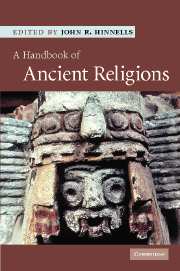Book contents
- Frontmatter
- Contents
- List of illustrations
- List of maps
- List of tables
- List of contributors
- Introduction
- 1 Palaeolithic art and religion
- 2 Ancient Egypt
- 3 Religion in ancient Ugarit
- 4 Mesopotamia
- 5 Ancient Israel to the fall of the Second Temple
- 6 Greek religion
- 7 Religions in the Roman Empire
- 8 Ancient Europe
- 9 The Indus Civilization
- 10 The religion of ancient China
- 11 Aztec and Inca civilizations
- Index
- References
11 - Aztec and Inca civilizations
- Frontmatter
- Contents
- List of illustrations
- List of maps
- List of tables
- List of contributors
- Introduction
- 1 Palaeolithic art and religion
- 2 Ancient Egypt
- 3 Religion in ancient Ugarit
- 4 Mesopotamia
- 5 Ancient Israel to the fall of the Second Temple
- 6 Greek religion
- 7 Religions in the Roman Empire
- 8 Ancient Europe
- 9 The Indus Civilization
- 10 The religion of ancient China
- 11 Aztec and Inca civilizations
- Index
- References
Summary
Introduction
The Aztec and Inca civilizations of the Americas rivalled their Old World counterparts in the size of their cities and the degree of influence over geographical areas. They were radically different from one another. Yet they are united by the fact that they both interacted directly with Europeans. It was out of this traumatic contact situation that came American culture which transformed the world.
Because of the contentious nature of the contact between cultures during the ‘Age of Discovery’, or that period immediately following 1492, surprisingly little of a certain factual nature can be said about the inner religious dimensions of Aztec and Inca civilizations. Indeed more can be discovered about these civilizations by examining them with reference to European civilizations. It is the gaps between various understandings of ‘religion’ that take us a long way towards understanding ancient America.
In the languages of neither the Aztecs (Nahuatl) nor the Incas (Quechua) is there a word equivalent to ‘religion’. In these civilizations there are no ‘religious’ institutions which are autonomous to other political or economic institutions. But if one looks to the literal meaning of ‘religion’ from the Latin ‘ligare’, which means ‘to bind’, then there is ample evidence of ‘religion’ among the Aztecs and Incas. But its emphasis is on a ceremonial ‘binding together’ rather than on textual ‘binding together’. Therefore the character of religion in the Americas was very different from its character in Europe and the Old World.
- Type
- Chapter
- Information
- A Handbook of Ancient Religions , pp. 537 - 576Publisher: Cambridge University PressPrint publication year: 2007



